The global solar power market is growing fast, with a 20.5% annual growth rate expected from 2023 to 2030. Flexible solar panels are key to this growth, with their market share set to hit 12% by 2025. These panels are great because they’re easy to carry, simple to install, and save energy.
They’re perfect for many uses, like charging batteries on the go, in boats, cars, and ATVs. Their light weight and flexibility make them very versatile.
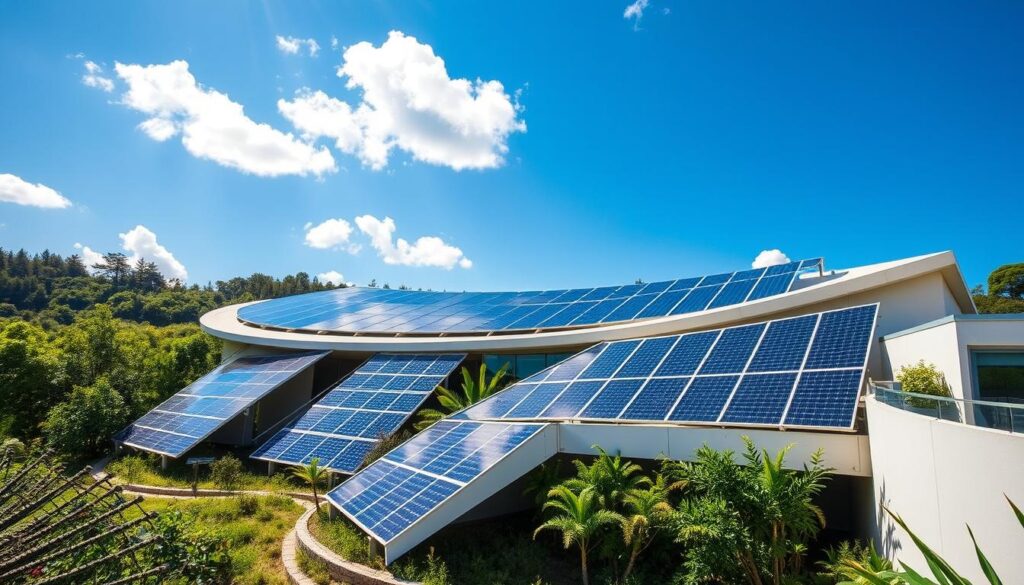
Flexible solar panels are getting more popular as people want more solar power. Their prices have dropped by about 30% from 2019 to 2023. Now, they cost around $1.50 per watt, making them more affordable.
These panels are also very light, weighing about 2.5 kg/m². This makes them much easier to handle than traditional panels, which is why they’re gaining traction in the renewable energy world.
Key Takeaways
- Flexible solar panels are expected to reach a market share of 12% by 2025.
- The global solar power market is projected to grow at a CAGR of 20.5% from 2023 to 2030.
- Flexible solar panels offer benefits such as portability, ease of installation, and energy efficiency.
- The cost of flexible solar panels has decreased by about 30% from 2019 to 2023.
- Flexible solar panels are suitable for various applications, including portable travel solar battery chargers and marine solar battery charging, due to their role in solar power and renewable energy.
- The average weight of flexible solar panels is approximately 2.5 kg/m², making them significantly lighter than traditional panels.
- Flexible solar panels are made from materials such as amorphous silicon, cadmium telluride, or copper indium gallium selenide (CIGS), which contributes to their growth in the renewable energy sector.
Understanding Solar Power Flexible Panels
Flexible solar panels are a sustainable energy solution with many benefits. They are lightweight and easy to install. This makes them perfect for outdoor use and rooftops. Using portable solar panels helps us use less non-renewable energy, making our future greener.
The technology behind flexible solar panel technology is thin-film solar cells. These cells are efficient and durable. They let solar panels bend and flex, unlike rigid panels. Flexible panels work well in low light and extreme temperatures.
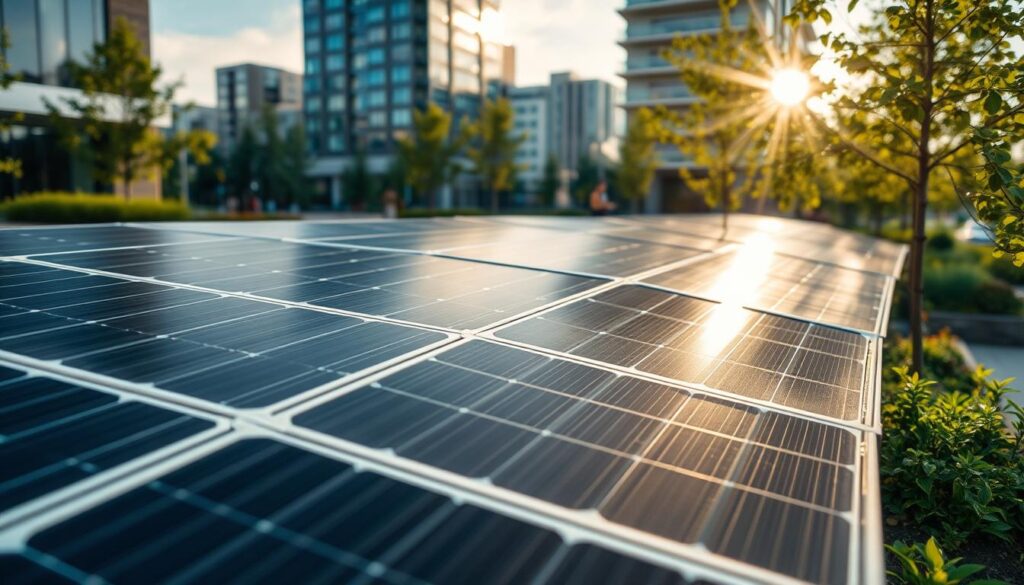
When thinking about flexible solar panels, look at their efficiency and durability. They might not be as good as rigid panels, but they’re powerful. Their flexibility and light weight make them easy to install and move, saving money and effort.
| Panel Type | Efficiency | Weight | Flexibility |
|---|---|---|---|
| Flexible Solar Panels | 15-18% | 4-8 pounds | Up to 360 degrees |
| Rigid Solar Panels | 20-23% | 20-30 pounds | None |
In summary, flexible solar panels have many benefits. They are great for outdoor use and rooftops because of their portability and ease of installation. As technology improves, we’ll see even better flexible solar panels, making them even more popular.
The Evolution of Flexible Solar Technology
The growth of flexible solar panels is a big step forward in renewable energy, mainly in solar power. Over time, flexible solar panel evolution has made panels more efficient, cheaper, and easier to get. Now, some panels can reach up to 22% efficiency.
The progress in flexible solar technology is impressive. The cost of solar power has dropped a lot, making it a cheap and effective renewable energy choice. New materials like amorphous silicon and organic photovoltaic cells have made panels lighter and more efficient. For example, some panels are now super thin and can produce over 2,720 watts per pound, much more than old silicon-based panels.
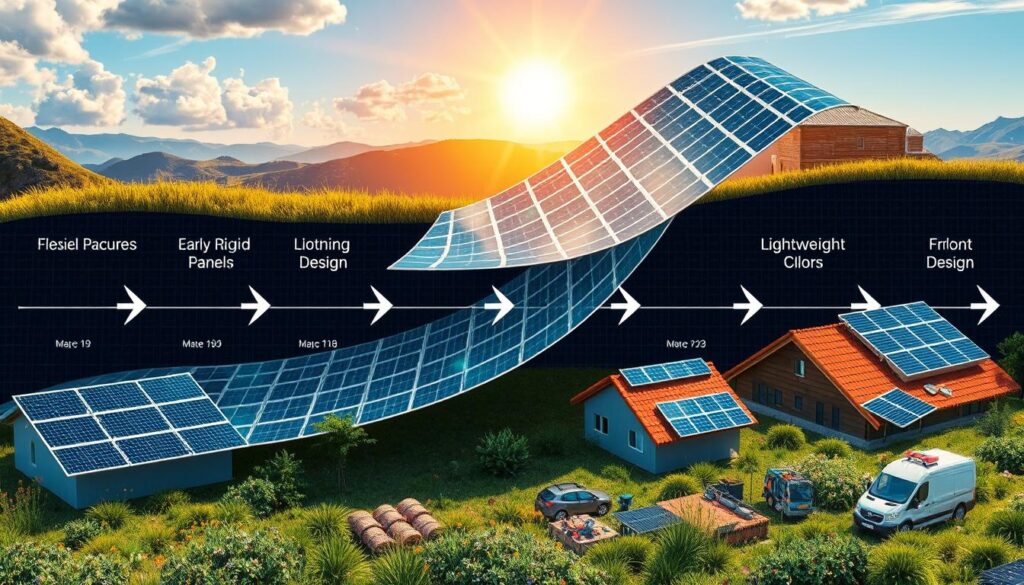
Flexible solar panels can power many things, like cities, cars, and small gadgets. As scientists keep working on flexible solar panels, we can expect even better panels soon. This will help the world move more towards renewable energy.
What makes flexible solar panels great includes:
- They’re light
- Easy to install
- Save space
These advantages, along with the ongoingflexible solar panel evolution, makesolar power a good choice for people and businesses wanting to userenewable energy.
Key Benefits of Flexible Solar Solutions
Flexible solar panels are light, making them easy to move and set up. This is great for portable solar power needs, where big panels are hard to handle.
These panels can go on odd shapes, like boats or RVs. They’re perfect for places where normal panels won’t fit. They also charge batteries and power gadgets in far-off places, giving a steady renewable energy solution.
Flexible solar panels have many benefits, including:
- Lightweight design
- Installation versatility
- Space optimization benefits
- Portability
- Aesthetically pleasing design
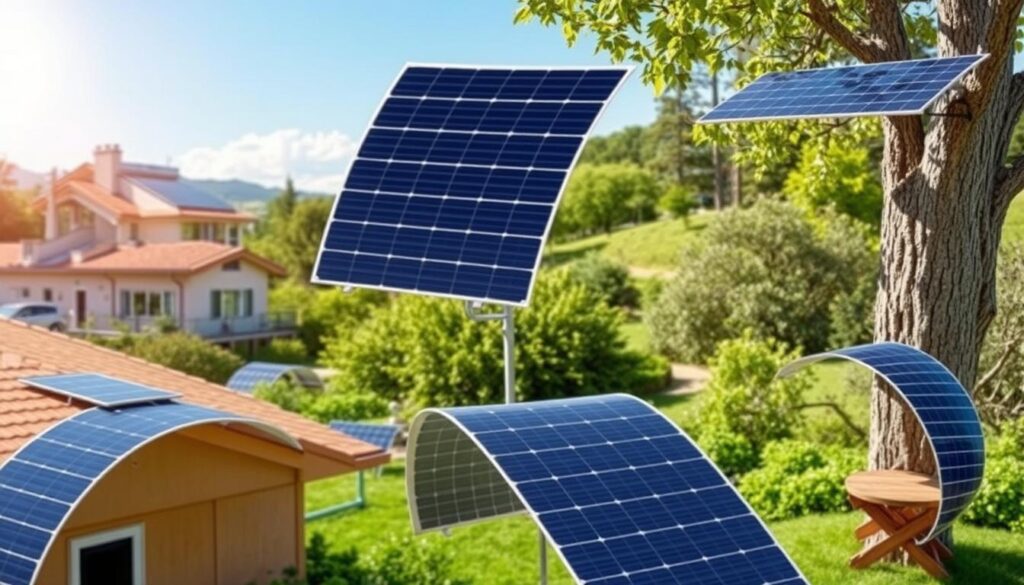
Flexible solar panels are a great choice for renewable energy solutions. They’re light, easy to install, and save space. They’re perfect for portable solar power and fixed setups.
| Benefit | Description |
|---|---|
| Lightweight design | Makes transportation and installation easier |
| Installation versatility | Can be installed on curved or irregular surfaces |
| Space optimization benefits | Can be used to charge batteries and power devices in remote areas |
Applications in Different Settings
Flexible solar panels are great for many solar power applications. They are light and flexible, making them easy to put on uneven places like RV roofs or boat decks. This is perfect for using renewable energy in remote spots or for moving around.
Some of the main uses of flexible solar panels are:
- Marine solar battery charging
- Automotive solar battery charging
- ATV solar battery charging
- Camping and off-grid solar power solutions
The special features of flexible solar panels let them fit on odd or curved surfaces. This means they can catch more energy. They are a top choice for renewable energy in many places.

In summary, flexible solar panels are a versatile and effective way to use solar power in different places. They are a great pick for anyone wanting to use renewable energy.
| Application | Benefits |
|---|---|
| Marine solar battery charging | Lightweight and flexible design, easy installation |
| Automotive solar battery charging | Portable and efficient, perfect for road trips |
| ATV solar battery charging | Durable and waterproof, ideal for off-road adventures |
Technical Specifications and Performance Metrics
Understanding flexible solar panel specifications is key for top solar power performance. Flexible solar panels are a big part of renewable energy systems. They have unique benefits and features.
The power output rating is a major spec. It can be from 55 watts to 240 watts for panels that work in shade.
Efficiency rates vary, with some panels reaching up to 24.4% efficiency. Size and weight are also important. Many premium panels weigh under 1 pound per square foot. They can bend up to 30 degrees, fitting various surfaces well.
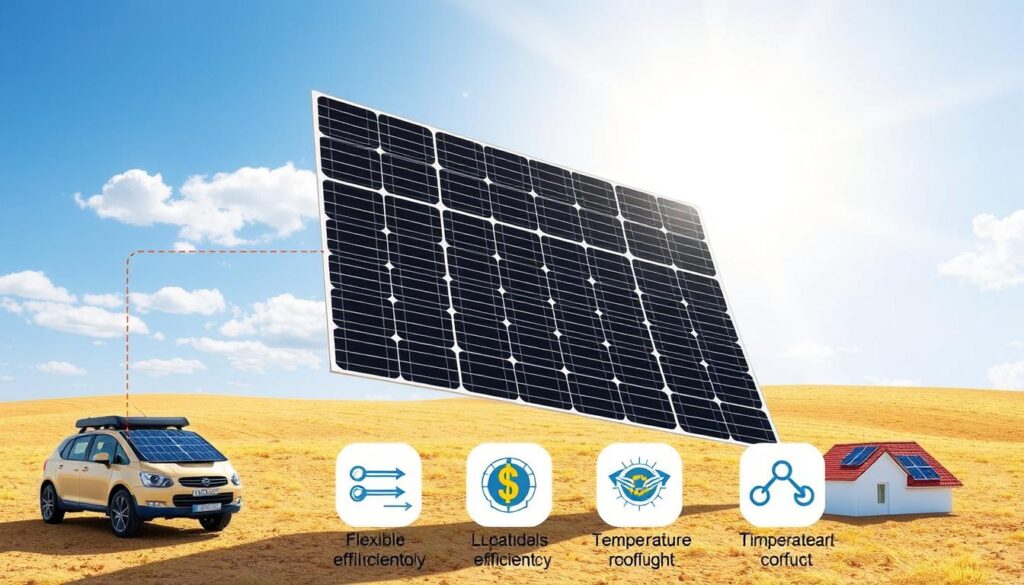
| Panel Type | Rated Power | Peak Power Voltage | Peak Power Amps | Cell Conversion Efficiency |
|---|---|---|---|---|
| 55 Watt Flexible Solar Panel | 55 Watts | 19.8 Volts | 2.9 Amps | 24% |
| 120 Watt Flexible Solar Panel | 120 Watts | 19.6 Volts | 6.2 Amps | 24.4% |
| 240 Watt Shade Tolerant Flexible Solar Panel | 240 Watts | 40.4 Volts | 6.0 Amps | 24.4% |
Knowing the specs and performance of flexible solar panels helps make smart choices. This ensures the best renewable energy system and solar power performance.
Installation Guidelines and Best Practices
When installing flexible solar panels, it’s key to follow the right steps for the best results. The first step is to pick a spot that gets lots of sunlight. Solar power installation might seem hard, but it’s worth it for renewable energy.
It’s best to have two people to help avoid air bubbles under the panel. Make sure not to bend the panel too much to avoid damage. When you apply the adhesive, press down carefully to get rid of air bubbles for a strong bond.
Important things to think about for flexible solar panel installation include:
- Check the panel’s size to make sure it fits
- Don’t bend the panel more than 2000 mm (about 6.6 ft)
- Use the right amount of adhesive and follow the application guide
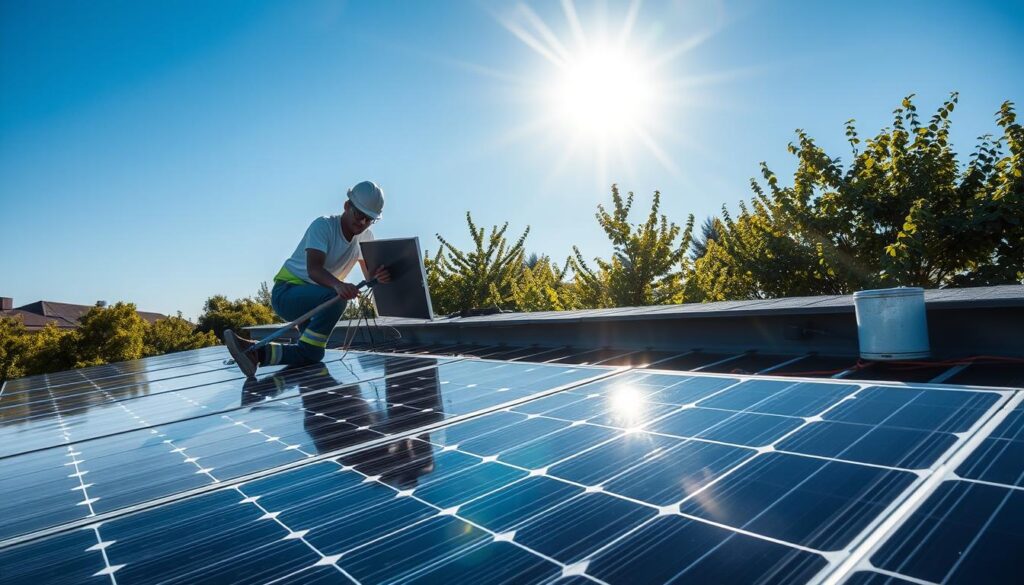
By sticking to these tips, you can make sure your solar power installation works well for a long time. It will give you a steady source of renewable energy.
| Panel Length | Maximum Arch Height |
|---|---|
| 50 cm (1.6 ft) | 16 mm (0.6 in) |
| 80 cm (2.6 ft) | 40 mm (1.6 in) |
| 100 cm (3.3 ft) | 62 mm (2.4 in) |
| 120 cm (3.9 ft) | 89 mm (3.5 in) |
| 140 cm (4.6 ft) | 121 mm (4.8 in) |
| 150 cm (4.9 ft) | 139 mm (5.5 in) |
| 170 cm (5.6 ft) | 178 mm (7.0 in) |
| 200 cm (6.6 ft) | 245 mm (9.6 in) |
Cost Analysis and ROI Considerations
When looking into flexible solar panels, the flexible solar panel cost is key. The cost for solar systems can be from $15,000 to $30,000 for a typical home. This depends on the system’s size and how complex it is. Yet, the solar power ROIcan be quite high, with yearly savings of $3,000 or more. This leads to a break-even point of about 6.67 years.
The long-term gains of renewable energy like solar power are clear. They offer a big return on investment and help cut down on greenhouse gas emissions. This makes them a great choice for those who care about the environment. Important cost factors include:
- Initial installation costs
- Costs for maintenance, like replacing inverters and cleaning panels
- Costs for energy storage systems
- Financial incentives, such as tax credits and net metering
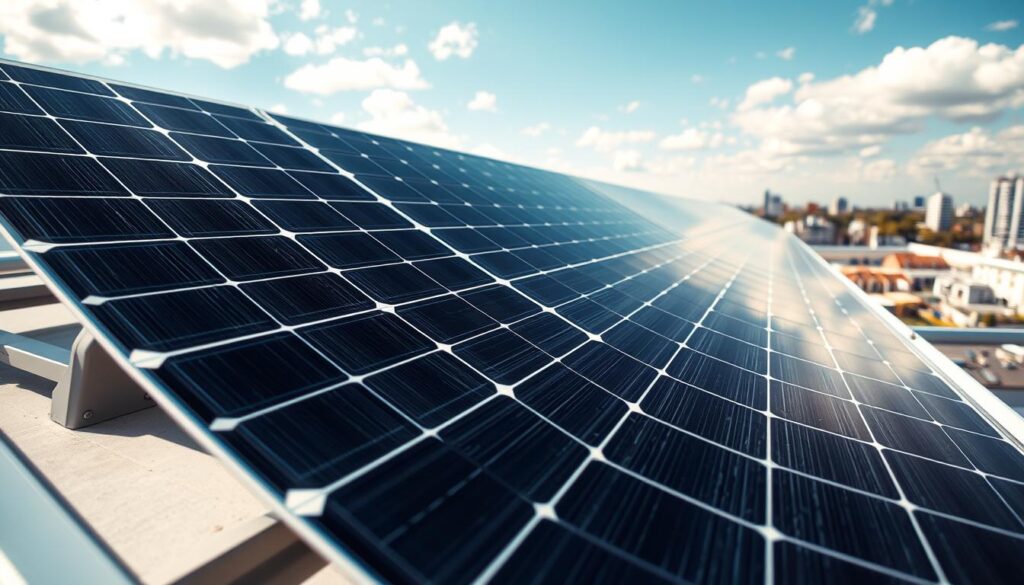
By knowing these costs and the solar power ROI, people and businesses can make smart choices. They can decide if investing in renewable energy like flexible solar panels is right for them.
Durability and Weather Resistance Features
Flexible solar panels are built to last, focusing on flexible solar panel durability and solar power weather resistance. They use strong materials like ETFE and TPT back sheets. These materials fight off corrosion and UV damage.
Flexible thin-film solar panels can handle tough weather and need little upkeep. This makes them perfect for renewable energy needs, even in harsh environments.
Some key features of flexible solar panels include:
- High-efficiency rates, with some panels achieving efficiency ratings of up to 22%
- Long lifespan, with some panels lasting up to 15 years or more
- Lightweight design, making them easy to transport and deploy
- Resistance to corrosion and UV rays, ensuring long-term performance and reliability

Flexible solar panels are a reliable and durable option for renewable energy needs. They focus on flexible solar panel durability and solar power weather resistance.
| Panel Type | Lifespan | Efficiency Rating |
|---|---|---|
| Monocrystalline | 10-15 years | 15-18% |
| Polycrystalline | 5-10 years | 12-15% |
| Amorphous Silicon | 5-10 years | 10-12% |
Comparing Different Brands and Models
There are many flexible solar panel brands out there. Top names include SunPower, QCELLS, and REC Group. They offer a variety of solar power models with different efficiency rates and prices.
SunPower’s solar panels are a favorite for many. They cost around $27,511 and have an efficiency of 22.8%. This makes them a top choice for those looking into renewable energy.
When it comes to performance, the MEGA 100 FLEX and MEGA 80 FLEX models stand out. They have high efficiency rates and are priced affordably. Here’s a table comparing some of the best flexible solar panel brands and models:
| Brand | Model | Efficiency | Price |
|---|---|---|---|
| SunPower | MEGA 100 FLEX | 22.8% | $27,511 |
| QCELLS | MEGA 80 FLEX | 22.5% | $21,768 |
| REC Group | REC 100 FLEX | 22.2% | $20,459 |
Choosing the right flexible solar panel brand and model depends on your needs and budget. Look at efficiency, price, and performance to make a smart choice. This way, you can invest in a renewable energy solution that fits your needs.
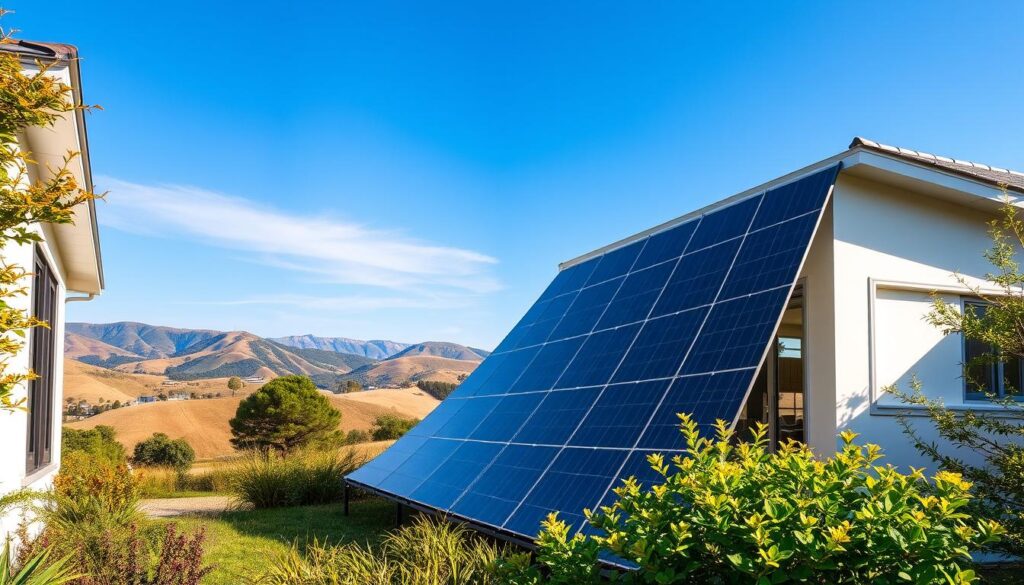
Maintenance and Care Requirements
Flexible solar panels need regular care to work well and last long. Proper care can make them last about 25 years. Cleaning them 2 to 4 times a year is key, depending on where you live and the weather.
If you live in a place with lots of snow or pollen, you might need to clean them more often. It’s important to clear snow and debris to avoid damage. Also, get a pro to check your renewable energy system once a year to catch any problems early.
Here are some important maintenance tips:
- Regular cleaning to remove dust and debris
- Inspections to detect problems early
- Professional servicing to ensure all parts are working right
By sticking to these tips and doing regular flexible solar panel maintenance, you can keep your renewable energy system running smoothly. This helps support a greener future.

Regular upkeep can spot problems before they get worse. This can save you money and keep your system running at its best. So, solar power care is a big deal for renewable energy systems.
| Maintenance Task | Frequency | Importance |
|---|---|---|
| Panel Cleaning | 2-4 times per year | High |
| Professional Servicing | At least once a year | High |
| Inspections | Regularly | Medium |
Integration with Existing Power Systems
Flexible solar panels are key in renewable energy. They can charge batteries and power devices in remote places. This makes them perfect for off-grid areas.
They work well with current power systems. This means a reliable and efficient energy source.
Flexible solar panels can store extra energy in batteries. This keeps the power steady, even when it’s dark. Plus, they can send extra energy to the grid. This lets homeowners and businesses earn money from it.
There are a few ways to connect flexible solar panels to power systems. These include:
- Battery storage options, such as lithium-ion batteries
- Grid connection methods, such as net metering and feed-in tariffs
Using flexible solar panels is a big step towards a greener future. It helps us use less fossil fuels and fight climate change.
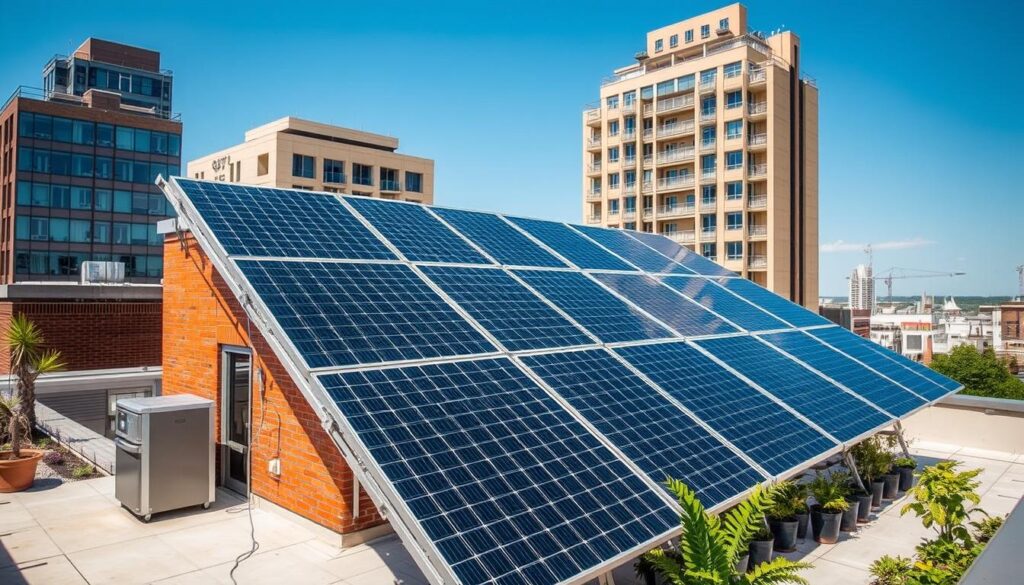
| Technology | Description |
|---|---|
| Lithium-ion batteries | A type of battery storage system commonly used in solar power systems |
| Net metering | A method of connecting solar panels to the grid and selling excess energy back to the utility company |
Environmental Impact and Sustainability
The flexible solar panel environmental impact is a big deal when we talk about renewable energy. As we move towards solar power sustainability, it’s key to look at how flexible solar panels affect our planet. In 2020, about 24% of the world’s energy was from renewable sources. India plans to hit 175 GW of renewable energy by 2022.
Flexible solar panels have some great benefits:
- Low carbon footprint
- High energy efficiency
- Recyclability
These advantages make flexible solar panels a good choice for those wanting to lessen their environmental footprint.
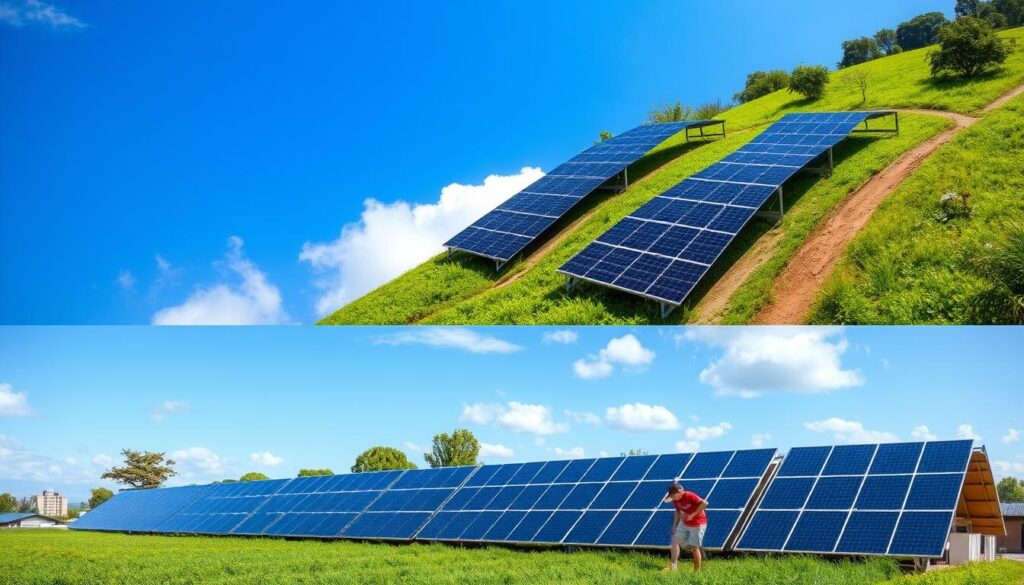
Flexible solar panels have made big progress in renewable energy production. They can now reach up to 11% efficiency, making them a strong competitor to traditional panels. The use of special carbon inks has also cut down on costs, thanks to not needing expensive metals like gold.
| Year | Renewable Energy Production | Flexible Solar Panel Efficiency |
|---|---|---|
| 2020 | 24% | 11% |
| 2022 | 175 GW | Up to 43% with advanced materials |
The future of flexible solar panel environmental impact and solar power sustainability looks bright. With the market growing and efficiencies improving, flexible solar panels will be key in our transition to renewable energy. They’ll help us use less of the earth’s resources and protect our natural spaces.
Common Challenges and Solutions
Flexible solar panels face several challenges, like installation problems and keeping them running well. But, with the right solutions, these issues can be solved. This way, we can use renewable energy more efficiently.
One big challenge is installation issues. For example, bending the panels too much can cause damage. To fix this, it’s important to install them correctly and handle them carefully.
For better performance, regular maintenance is key. This means keeping the panels clean and checking them often for damage.
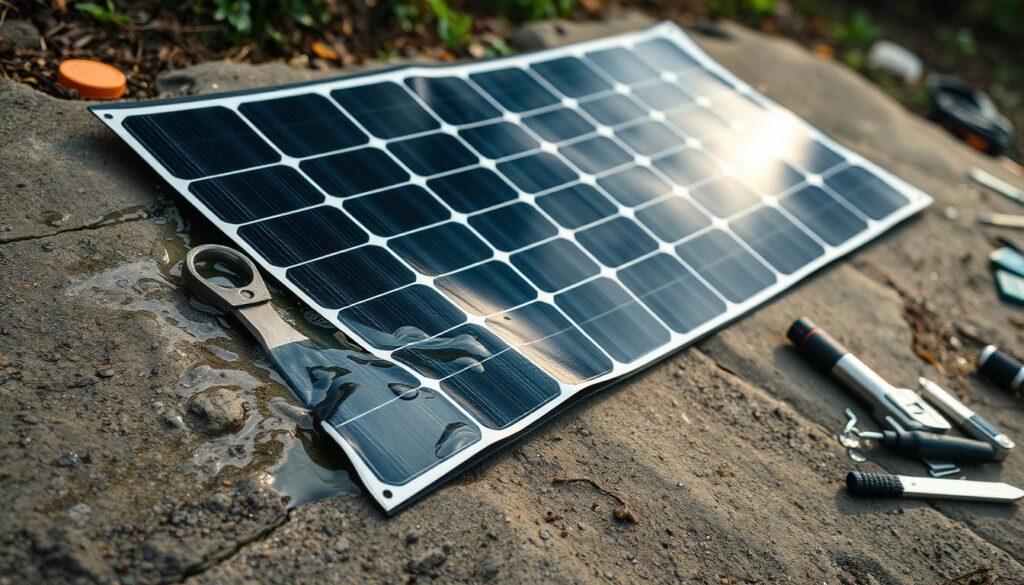
To tackle these challenges, choose panels made from strong materials like UV-resistant ETFE. Also, make sure to install them right and maintain them well. This ensures they work efficiently, giving us a steady source of clean energy.
Future Developments in Flexible Solar Technology
The flexible solar panel future is looking bright. Ongoing solar power developments aim to boost efficiency, durability, and use. Flexible solar panels are key in renewable energy solutions, making solar energy more accessible and integrated in many industries.
The global flexible solar panel market is expected to hit USD 8.4 billion by 2027. This growth comes from new tech like thin-film solar cells and better materials. Flexible solar panels can work in many places, making them vital in renewable energy.
Flexible solar panels are light, easy to install, and save space. These traits make them perfect for vehicles, buildings, and portable chargers. As solar power developments keep improving, we’ll see more uses of flexible solar tech in the flexible solar panel future.

The table below shows some key stats and trends in the flexible solar panel market:
| Category | Description | Value |
|---|---|---|
| Market Size | Projected global flexible solar panel market size by 2027 | USD 8.4 billion |
| Growth Rate | Projected annual growth rate for the building-integrated photovoltaics (PV) market | 21% |
| Efficiency | Record-breaking conversion rate for a non-fullerene organic solar cell | 17.4% |
Looking ahead, flexible solar panel future shows solar power developments are key in renewable energy. With tech and use improvements, flexible solar panels will greatly impact energy generation and use.
Regulatory Compliance and Certification
Manufacturers of flexible solar panels must follow strict rules to ensure their products are safe and work well. They need to meet the IEC 61701 standard for panels near the coast. This standard checks if the panels can resist salt mist corrosion.
In places with lots of snow, panels need to handle more weight. The IEC 61215 standard is usually 2400 Pa, but 5400 Pa is better for snowy areas. The UL 1703 standard also requires panels to work at least 90% as well as they claim.
The solar power certification process includes many tests. These tests check the panels’ electrical, mechanical, and climate performance. The IEC 61730 standard makes sure panels are safe, covering electrical, mechanical, thermal, and fire safety.
The CE marking is a must for solar panels sold in the European Economic Area (EEA). It shows the panels meet EU safety and environmental rules.
As we move towards more renewable energy, the need for solar panels is growing. Over 115 gigawatts (GW) of solar energy are expected worldwide. To meet this demand, manufacturers must follow strict standards and certifications. ISO 9001, ISO 14001, and ISO 45001 help with quality, environmental, and safety management.
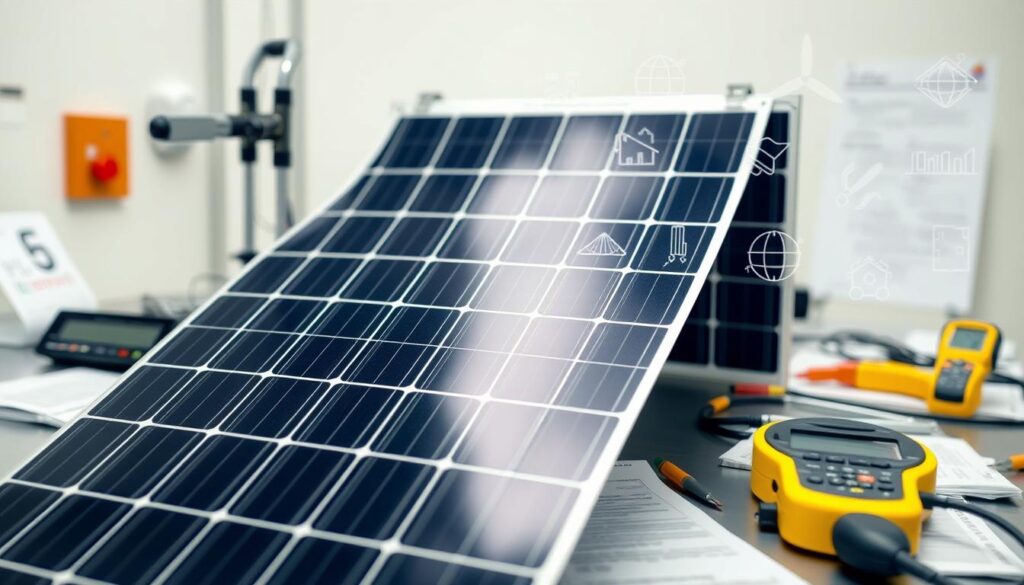
- IEC 61215: Standard for crystalline silicon terrestrial photovoltaic (PV) modules
- IEC 61730: Standard for photovoltaic (PV) module safety
- UL 1703: Standard for flat-plate photovoltaic modules and panels
- CE marking: Mandatory requirement for solar panels and components sold in the European Economic Area (EEA)
Conclusion: Embracing the Future of Solar Energy
Looking ahead, flexible solar panels are set to change the game in renewable energy. They promise better efficiency, are lighter, and can be installed in many ways. This makes them key to making solar power more common in homes and businesses.
Thanks to new materials and engineering, these panels can now convert more than 30% of sunlight into electricity. This is as good as older panels. Plus, new tech like bifacial cells and perovskite solutions make them even better at catching the sun’s rays. This makes them a great choice for anyone wanting to use more renewable energy.
Flexible solar panels are also super easy to install on different shapes and sizes. They can go on curved roofs, awnings, and even cars. This means we can use solar energy in places we never thought possible. It makes solar power more accessible to everyone.
As we all try to be more green and cut down on carbon, flexible solar panels will be very important. With help from governments, rules, and more people learning about them, solar energy’s future looks bright. By using these new panels, we can make our energy system better for the planet and for future generations.
FAQ
What are flexible solar panels?
Flexible solar panels are a new kind of solar tech. They are light, easy to carry, and simple to put on different surfaces. Unlike regular solar panels, they can bend and fit various shapes.
How do flexible solar panels differ from traditional panels?
Flexible solar panels use new materials and tech. This makes them lighter, more portable, and flexible. They work well on curved surfaces like RVs, boats, and buildings. They’re great for camping and emergency power needs too.
What are the key benefits of using flexible solar panels?
Flexible solar panels are light, easy to install, and save space. They fit on many surfaces, making them perfect for remote areas. They’re also more energy-efficient and cost-effective than traditional panels.
Where can flexible solar panels be used?
You can use flexible solar panels for many things. They’re good for travel, boats, cars, and even remote areas like construction sites. They’re also useful in emergency situations.
What are the technical specifications and performance metrics of flexible solar panels?
Flexible solar panels vary in power, efficiency, size, and weight. These details affect how well they work. It’s important to look at these specs when picking the right panel for you.
How do I install and maintain flexible solar panels?
Installing and keeping up with flexible solar panels is key. Choose the right spot, attach them securely, and clean them often. This keeps them working well for a long time.
What are the cost considerations for flexible solar panels?
Flexible solar panels might cost more upfront. But they save money on energy over time. Think about maintenance and battery storage when figuring out the total cost and benefits.
How durable and weather-resistant are flexible solar panels?
Flexible solar panels are built to last and handle tough weather. They can stand up to extreme temperatures, humidity, and UV rays. They’re made for long-term use outdoors.
What are the environmental and sustainability benefits of flexible solar panels?
Flexible solar panels are good for the planet. They cut down on carbon emissions, use energy better, and might be recyclable. They help us move towards a greener energy future.
What are the future developments in flexible solar technology?
Flexible solar tech is getting better with new materials and designs. As it keeps improving, these panels will play a bigger role in renewable energy.